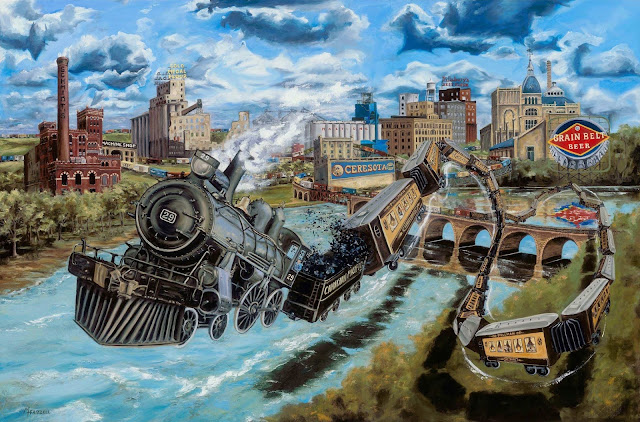By IASP.
Tracy Frizzell's use of American iconography portraying post-industrialized environments is the best stage for a fantastic narrative. The extensive presence of local landmarks is welcomed as it places us at the border of reality and fiction, in which Tracy Frizzell, the author of Trains, opens her imagination to create a new layer that overlaps reality without destroying it.
The author, Tracy Frizzell, is located on the fourth floor of the Northrup King Building (1500 Jackson St NE, Minneapolis, MN 55413).
Magic realism is one of - if not- the most important and innovative literary movements of this century. Taking place in Latin America, magic realism reflects the coexistence of development and traditions. Some of the most well-known writers of this movement are Gabriel Garcia Marquez, Julio Cortazar, Jorge Luis Borges, and Isabel Allende -my fellow compatriot.
Yet, it's in painting where Magic Realism finds its roots; the best place for daydreaming. Back in 1925, Franz Roh used this concept to explain the post-expressionism in painting for the first time. Those extraordinary images from the painter's mind become ordinary on the canvas as those are imbued with morning light.
Here, Tracy's brushes and oil painting match the blurring of the lines between fantasy and reality. We are not challenged to enter a new world, but we found ourselves watching the same city that we know and experience in a daily basis. The trains are part of the Midwestern ethos, which are also frequent remains of the past around the Cities. These flying trains are extraordinarily part of our routine. We share an experience.
The Foshay Tower one is my favorite because of this shared experience as it has decorated the night of the Cities since 1929. The work of Tracy Frizzell plays with our collective memory. These pieces are an open invitation to experience the magic of our daily routine through shared images, landmarks, and style.
It's like rediscovering the extraordinary from our ordinary routine that was always there. These images, like shared believes, provides Tracy with a system of references from which she does erase the borders between reality and fiction. We accept these trains as something normal. It's only the landmarks and images, the style itself seems to be taken from advertisements and colors of that era.
To conclude, Trains is a very interesting proposal that combines a fantastic narrative blurred in our daily experience across these landmarks. visit her gallery the next available time. If you want to know more about Tracy Frizzell's artwork, her website is http://tracyfrizzell.com/



















0 Comentarios